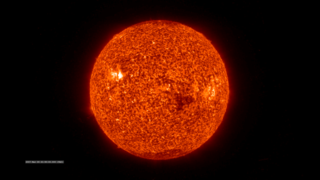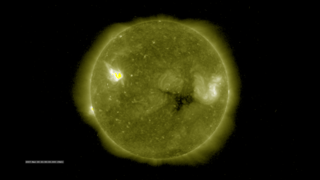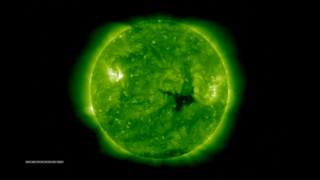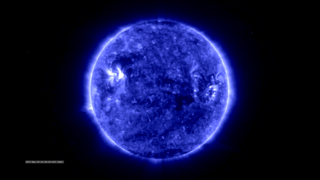Sun
ID: 12393
This 3-D video can be seen with red and cyan 3-D paper glasses.
Launched ten years ago, on Oct. 25, 2006, the twin spacecraft of NASA’s STEREO mission – short for Solar and Terrestrial Relations Observatory – have given us unprecedented views of the sun.
In 2007, STEREO provided the first multi-viewpoint images of the sun. For the first time, scientists were able to see structures in the sun's atmosphere in three dimensions. Then, in 2011, they gave us the first-ever simultaneous view of the entire star at once. This kind of comprehensive data is key to understanding how the sun erupts with things like coronal mass ejections and energetic particles, as well as how those events move through space, sometimes impacting Earth and other worlds. Ten years ago, the twin STEREO spacecraft joined a fleet of NASA spacecraft keeping an eye on the sun and its influence on Earth and space – but they provided a new and unique perspective.
The two STEREO observatories, called STEREO-A and STEREO-B – for Ahead and Behind, respectively – were sent out from Earth in opposite directions. Using gravitational assists from both the moon and Earth, the STEREO spacecraft were accelerated to Earth-escape velocities. STEREO-A was inserted into an orbit slightly smaller, and therefore faster, than Earth’s. For STEREO-B, the reverse happened: It was nudged into an orbit slightly larger than Earth’s so that it traveled around the sun more slowly, falling increasingly behind the Earth. As the spacecraft slowly fanned out away from the centerline between Earth and the sun – where every other sun-watching spacecraft is located – they revealed more and more new information about our closest star.
This footage is from March and April 2007, when the small separation of the two spacecraft allowed a stereoscopic view of the sun similar to how human eyes perceive the world around us. These images were captured by STEREO in several wavelengths of extreme ultraviolet light which show different layers of the sun’s atmosphere. The number in the lower right of the video shows the wavelength of light measured in Angstroms.
Music: "Soothing" and “Serendipity" from Erstwhile
All tracks written and produced by Lars Leonhard
www.lars-leonhard.de

3D 4k for STEREO's 10th Anniversary
Launched ten years ago, on Oct. 25, 2006, the twin spacecraft of NASA’s STEREO mission – short for Solar and Terrestrial Relations Observatory – have given us unprecedented views of the sun.
In 2007, STEREO provided the first multi-viewpoint images of the sun. For the first time, scientists were able to see structures in the sun's atmosphere in three dimensions. Then, in 2011, they gave us the first-ever simultaneous view of the entire star at once. This kind of comprehensive data is key to understanding how the sun erupts with things like coronal mass ejections and energetic particles, as well as how those events move through space, sometimes impacting Earth and other worlds. Ten years ago, the twin STEREO spacecraft joined a fleet of NASA spacecraft keeping an eye on the sun and its influence on Earth and space – but they provided a new and unique perspective.
The two STEREO observatories, called STEREO-A and STEREO-B – for Ahead and Behind, respectively – were sent out from Earth in opposite directions. Using gravitational assists from both the moon and Earth, the STEREO spacecraft were accelerated to Earth-escape velocities. STEREO-A was inserted into an orbit slightly smaller, and therefore faster, than Earth’s. For STEREO-B, the reverse happened: It was nudged into an orbit slightly larger than Earth’s so that it traveled around the sun more slowly, falling increasingly behind the Earth. As the spacecraft slowly fanned out away from the centerline between Earth and the sun – where every other sun-watching spacecraft is located – they revealed more and more new information about our closest star.
This footage is from March and April 2007, when the small separation of the two spacecraft allowed a stereoscopic view of the sun similar to how human eyes perceive the world around us. These images were captured by STEREO in several wavelengths of extreme ultraviolet light which show different layers of the sun’s atmosphere. The number in the lower right of the video shows the wavelength of light measured in Angstroms.
Music: "Soothing" and “Serendipity" from Erstwhile
All tracks written and produced by Lars Leonhard
www.lars-leonhard.de

Source Material
For More Information
Credits
Scott Wiessinger (USRA): Lead Producer
Tom Bridgman (Global Science and Technology, Inc.): Lead Visualizer
Scott Wiessinger (USRA): Editor
Genna Duberstein (USRA): Producer
Sarah Frazier (ADNET Systems, Inc.): Science Writer
Tom Bridgman (Global Science and Technology, Inc.): Lead Visualizer
Scott Wiessinger (USRA): Editor
Genna Duberstein (USRA): Producer
Sarah Frazier (ADNET Systems, Inc.): Science Writer
Please give credit for this item to:
NASA's Goddard Space Flight Center
NASA's Goddard Space Flight Center
Short URL to share this page:
https://svs.gsfc.nasa.gov/12393
Mission:
STEREO
Data Used:
Note: While we identify the data sets used in these visualizations, we do not store any further details nor the data sets themselves on our site.
This item is part of these series:
Narrated Movies
STEREO at Ten
Keywords:
GCMD >> Earth Science >> Sun-earth Interactions >> Solar Activity >> Solar Ultraviolet
SVS >> SDO
SVS >> Heliophysics
SVS >> STEREO
SVS >> 3-D
SVS >> Corona
NASA Science >> Sun
SVS >> 4K
GCMD keywords can be found on the Internet with the following citation: Olsen, L.M., G. Major, K. Shein, J. Scialdone, S. Ritz, T. Stevens, M. Morahan, A. Aleman, R. Vogel, S. Leicester, H. Weir, M. Meaux, S. Grebas, C.Solomon, M. Holland, T. Northcutt, R. A. Restrepo, R. Bilodeau, 2013. NASA/Global Change Master Directory (GCMD) Earth Science Keywords. Version 8.0.0.0.0
https://svs.gsfc.nasa.gov/12393
Mission:
STEREO
Data Used:
STEREO/Extreme UltraViolet Imager (EUVI)
This item is part of these series:
Narrated Movies
STEREO at Ten
Keywords:
GCMD >> Earth Science >> Sun-earth Interactions >> Solar Activity >> Solar Ultraviolet
SVS >> SDO
SVS >> Heliophysics
SVS >> STEREO
SVS >> 3-D
SVS >> Corona
NASA Science >> Sun
SVS >> 4K
GCMD keywords can be found on the Internet with the following citation: Olsen, L.M., G. Major, K. Shein, J. Scialdone, S. Ritz, T. Stevens, M. Morahan, A. Aleman, R. Vogel, S. Leicester, H. Weir, M. Meaux, S. Grebas, C.Solomon, M. Holland, T. Northcutt, R. A. Restrepo, R. Bilodeau, 2013. NASA/Global Change Master Directory (GCMD) Earth Science Keywords. Version 8.0.0.0.0















